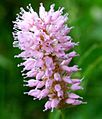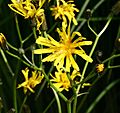Mar Field Fen facts for kids
| Site of Special Scientific Interest | |

Common butterwort grows at Mar Field Fen
|
|
| Area of Search | North Yorkshire |
|---|---|
| Coordinates | 54°13′56″N 1°39′39″W / 54.2323°N 1.6609°W |
| Interest | Biological |
| Area | 8.8809 hectares (0.08881 km2; 0.03429 sq mi) |
| Notification | 2 October 1988 |
| Location map | Magic Map (Defra) |
Mar Field Fen is a Site of Special Scientific Interest, or SSSI, north of Masham, North Yorkshire, England, in a rural area known as Marfield. It is situated on land containing woodland carr, fen, spring-fed marshy grassland and drier calcareous grassland, between the River Ure to the east and Marfield Wetland nature reserve to the west. As "one of the best examples of fen habitat in the Vale of York," it is a protected habitat for a variety of plants, including the common butterwort, a carnivorous plant. There is no public access to this site.
Site history
In the 19th century, the site was in hunting country, where the Bedale Hunt would run. The entrants for the annual Bedale Hunt steeplechase would gather in a field called Marfield, a drier place adjacent to the present SSSI site, before moving on to a field called Whitefield for the start of the race.
Site location and designation
Mar Field Fen is a 8.8809 hectares (0.08881 km2; 0.03429 sq mi) biological Site of Special Scientific Interest (SSSI), consisting of woodland carr, fen and calcareous meadow whose flush and spring fed soils support certain specialised vegetation. The site lies north of Masham, North Yorkshire, on the west bank of the River Ure. There are public footpaths to the east and west of the site, but no public access, vehicle access or facilities. The site was notified on 2 October 1988, being of interest for being "one of the best examples of fen habitat in the Vale of York."
Mar Field Fen SSSI is not to be confused with Marfield Wetlands nature reserve which contains lakes, and lies to the west of the SSSI. Unlike the SSSI, Marfield Wetlands has a car park, bird hides and public facilities.
Significant site content
Flora
On the fen meadow are many species of herbaceous plants, including spotted orchid, common bistort, greater bird's foot trefoil, common valerian, marsh hawksbeard, wild angelica, ragged robin and meadowsweet. These grow beside or among the "locally uncommon" blunt-flowered rush and greater tussock-sedge. Other fen plants here include common reed (Phragmites australis), jointed rush, hairy sedge and lesser pond sedge. Within the site there is also a drier calcareous grassland with its own flora.
At the north end of the site there is "flushed ground," or land with much seepage from the aquifer; some of its plants are "particularly scarce and localised." For example, there is the brown moss Drepanocladus revolvens and tussocks of purple moor-grass. There are also tussocks of bog rush, and on these tussocks are common butterwort and flea sedge. The fen spring-lines have their own special plants: broad-leaved cottongrass (Eriophorum latifolium) which is classed as "uncommon", bogbean, early marsh orchid, marsh valerian (Valeriana dioica), glaucous sedge, carnation sedge and long-stalked yellow sedge (Carex lepidocarpa).
-
Broad-leaved cottongrass (Eriophorum latifolium)
Where the fen meadow and woodland carr meet, there is giant bellflower, marsh horsetail, hemp agrimony, yellow iris or flag, marsh marigold and meadowsweet. In drier places under the trees are: wood anemone, enchanter's nightshade and dog's mercury. Above them in the woodland understorey are guelder rose and grey willow or common sallow. The woodland carr itself has been partially planted with pine and poplar, but the remaining natural or original canopy is ash and alder.
Maintenance
In the woodland carr, minimum interference with natural growth and die-back is recommended, because fallen trees and regrowth will encourage the natural development of diverse habitats, such as glades, areas of young trees, and a mixture of light and shade, and shelter or exposure to wind. It may sometimes be necessary to cut back scrub if the woodland encroaches onto meadow, or to coppice trees to open up the area to light or to prevent trees from falling. Public access should be restricted to protect breeding wildlife or for the sake of public safety.
The flush and spring fen area should be protected from potential risk of commercial water abstraction which would deplete the aquifer, and from agricultural fertiliser or landfill pollution. All of these would disrupt the chemical balance in the aquifer and consequently in the soil, and that in turn would encourage rank grasses, and cause depletion of specialised fen plants. The quality of fen biodiversity should be monitored for signs of change. Light autumn grazing and trampling by cattle is beneficial, so long as the land is not enriched by cattle dung or feed. Moderate trampling may break down leaf litter and create scattered areas of bare soil which would encourage bryophytes and some invertebrates. Drains should not interfere with flushes and springs, nor should they cause any drying-out of land. At this particular site there is necessary incoming water from an adjacent quarry, and that should not be withheld, diverted or obstructed.
The calcareous meadow area requires more maintenance than the wood and fen. To prevent build-up of rank grasses, dead vegetation and scrub, light annual grazing and trampling by cattle is recommended. The aim is to "keep a relatively open sward without causing excessive poaching" and a varied habitat, including perhaps a controlled amount of scrub. Pesticides, herbicides and fertiliser are strongly discouraged. Rabbit damage is a problem on this site, and should be controlled where possible.



















